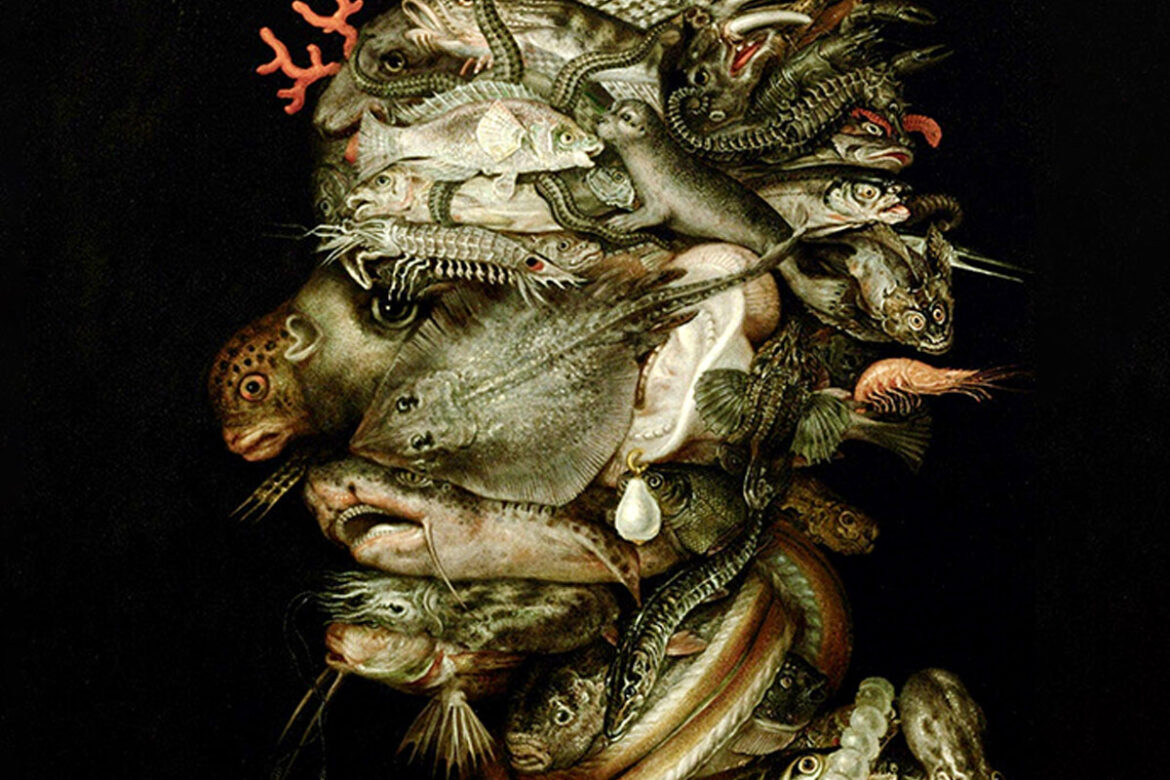I came across the work of Arcimboldo at the impressionable age of about 8, pawing (illicitly) through my big brother’s record album collection. Flip. Flip. Flip. And then I saw it: Kansas’s Masque. The cover was a detail of Giuseppe Arcimboldo’s Water (1566) from his series, The Four Elements. Obviously, I didn’t know that as I sat cross-legged on a scratchy Rya rug. While I had zero use for the music, I just knew that I was holding the coolest album cover that I had ever seen: a face and shoulders composed of tiny, minutely observed sea creatures, the open maw of a shark arcing into a sinister, off-kilter sneer. I was transfixed.
Turns out, there’s a lot to be creeped out by in Arcimboldo’s work—he was a court portraitist to Holy Roman Emperor Rudolf II. His job was flattery. Sure, the paintings of royal heads composed of fruits and fish are funny, but, as Thomas DaCosta Kaufmann, author of Arcimboldo: Visual Jokes, Natural History, and Still-Life Painting, says in Smithsonian Magazine, they also symbolize “the majesty of the ruler, the copiousness of creation and the power of the ruling family over everything.”
Meanwhile, Arcimboldo was really peacocking his Renaissance artist cred. In the guise of painting his patrons, he’s shouldering up to those more heavy-duty observers of nature, Michelangelo and DaVinci. His fruits and fish are so realistic, they’re almost fragrant.
Arcimboldo’s era was the Italian Renaissance, and his way of using food was to paint it, but his work points to modern parallels between era and the presentation of food. Consider the go-go ’80s, a time when greed was good and hair was high. This moment of boundless, guiltless aspiration launched the era of Tall Food. Often credited to Alfred Portale of Gotham Bar and Grill, this was when ring-molded stacks of food were crowned, pineapple-like, by vertically oriented lettuce leaves. I remember sweating in sympathy as waiters teetered these Icarian structures through dining rooms. I also remember the ghastly trickle down as Tall Food was plated by less artful hands. One restaurant achieved height with twin deep-fried sticks of uncooked spaghetti springing, antennae-like, from the pile-up. I could have been pithed.
Fashion is a pendulum, and every yin has its yang. The druggy, grunge and E-fueled ’90s ushered in a much more chill style of plating. Herbs were now flopped out on something comfy, rustic and Tuscan—probably polenta. Squeeze bottles had their big moment, loosely and expressively Pollocking up every plate. You lounged sideways, Fiona Apple–like, across Shabby Chic chairs-and-a-half and left patinas of wine rings on Tuscan refectory tables. Martini and wine glasses became supersized so, in your drunkenness, you achieved the eye-glaze of heroin chic.
In the oughts, artifice rebounded when the internet revolution collided with molecular gastronomy. Rustic was over, and suddenly food really loved tech: Anything was possible. You were eating things that looked like other things, and everything was a bit of a joke. Homaro Cantu was out in Chicago, pressing sushi-flavored paper, edibly ink-jetted with images of maki. At wd~50, you tucked into soils, with puckish Wylie Dufresne making his customers symbolically eat dirt. Spherification bounced everywhere, and our plates resembled Barbie-sized ball pits. Finally, in San Sebastian (where this all started), the internet-and-molecular-gastronomy dream team achieved its ultimate creation. At Arzak, seafood was served on iPads playing videos of waves breaking on the beach.
That excess might just have cued the return to primitivism of the twenty-teens, an era when people, burned by tech’s failures and demands, yearned for the simplicity of yoga, beekeeping and rural chic. Suddenly live-fire cooking became the hottest way to party like a pagan, and we gathered around Francis Mallmann’s outdoor installations of crackling meats, cabbage lanterns and spectacle fires in religious awe. On these shores, steampunk infiernillos cropped up, their exaggerated chains and cranks hearkening to a sturdier, more trustworthy, pre-dotcom age.
It’s too early to tell what the next era of plating will reveal about us right now, but, to me, all these dizzyingly intricate charcuterie and grazing boards hint at a return to Arcimboldo.
This story originally appeared in the Spring ’22 issue of Edible Manhattan and Edible Brooklyn. To be the first to see stories like this, subscribe to our print magazine here.



